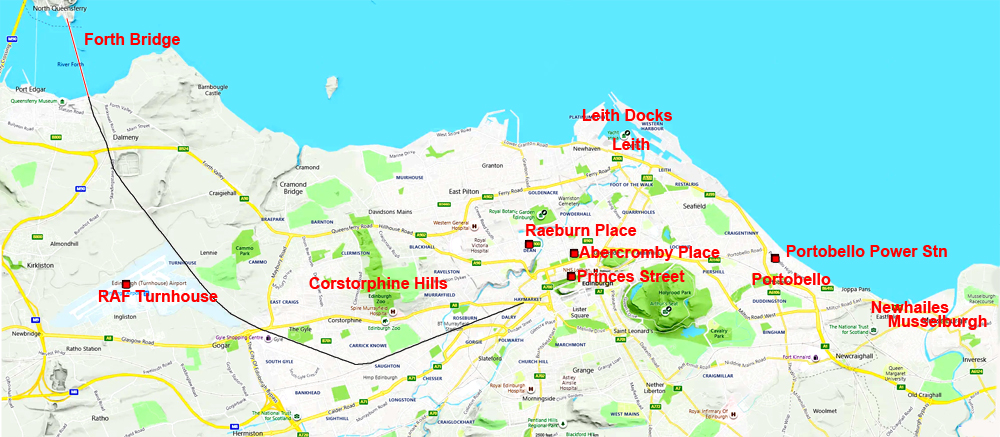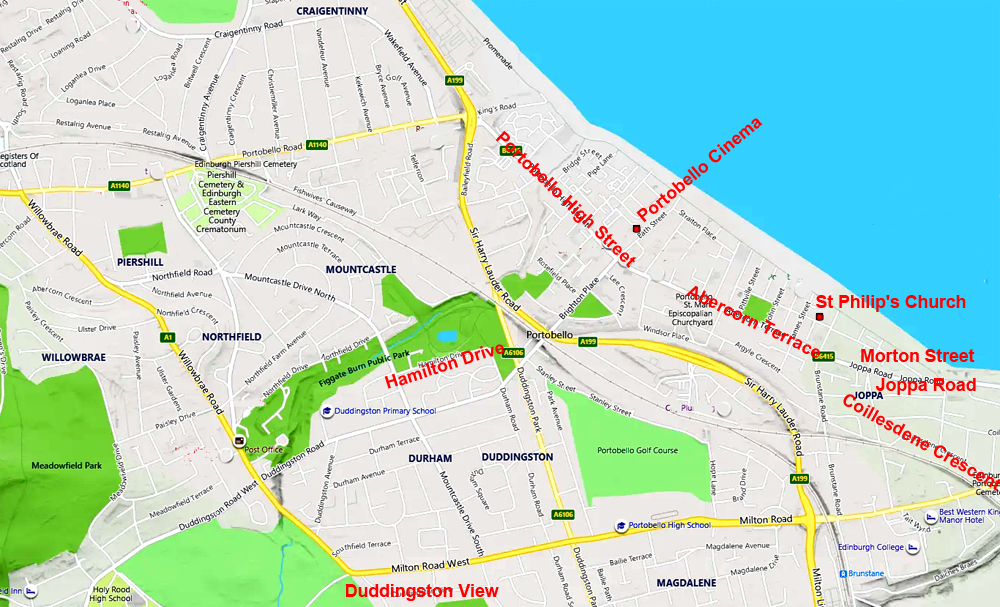First Air Raid of WWII – 35
16:00 – a chase over the city
| < 34 Fending off the 4th wave | Δ Index | 36 interception at Inverkeithing > |

Another Ju88 was intercepted by 603’s P/O Robbie Robertson as it headed south from the Forth Bridge ‘following the railway line north of the aerodrome at 150 feet’ towards Edinburgh and home.
Robbie had re-armed and re-fuelled at Turnhouse and had taken off at 15.40 hours for his second patrol of the day. 20 minutes later witnesses watched him chase the Ju88, with its sinister black crosses, north of the airfield at Turnhouse at an altitude of nearer 300 feet.
The gunners manning the airfield gun emplacements resisted the temptation to open fire in case they hit the Spitfire by mistake. Nevertheless, they, along with the 603 padre, cheered on their man as he roared past. On seeing the two aircraft approaching, Black Morton rushed to his own Spitfire and, without obtaining permission, took off. The Squadron ORB confirms his take-off time as 16.00.
Whilst keeping Robbie in his sights as he pursued the German north-east towards Leith, Black attempted to gain ground by flying east, straight across the centre of Edinburgh. Thus began a most spectacular low-level chase across the rooftops of the Scottish capital, Robertson close on the tail of the German with Black to the south, racing towards Portobello and a successful interception.
Eye witnesses spoke of seeing the aircraft (Robertson and the Ju88) very close together, and hearing the rattle of machine-gun fire although Robbie claimed he withheld fire whilst over the City until they reached the suburbs.
Robbie’s chase continued over Raeburn Place and past the Royal Scots Club in Abercromby Place where a meeting was in progress. Legend has it that as the Ju88 roared past within sight of those at the table, the Chairman exclaimed: ‘My God, that’s a Jerry!’ Apparently, after a moment’s silence, the meeting continued as if nothing had happened.
 Black finally caught up with his colleague and the German intruder south-west of Portobello and immediately opened fire. At 10 Hamilton Drive the masonry was pitted by several bullets and two of his spent .303 rounds drilled holes in the upstairs parlour window. The home belonged to Lord Provost, Sir Henry Steele. The bullets smashed the mirror of an antique display cabinet, damaging one small Japanese vase in a valuable collection of ivories and china. Sir Henry later recovered one of the bullets from the room and returned it to 603 Squadron at Turnhouse (a few years later the position of Lord Provost was occupied by Will Darling – corset maker to three queens – and HAC to 603 Squadron).
Black finally caught up with his colleague and the German intruder south-west of Portobello and immediately opened fire. At 10 Hamilton Drive the masonry was pitted by several bullets and two of his spent .303 rounds drilled holes in the upstairs parlour window. The home belonged to Lord Provost, Sir Henry Steele. The bullets smashed the mirror of an antique display cabinet, damaging one small Japanese vase in a valuable collection of ivories and china. Sir Henry later recovered one of the bullets from the room and returned it to 603 Squadron at Turnhouse (a few years later the position of Lord Provost was occupied by Will Darling – corset maker to three queens – and HAC to 603 Squadron).
Alexander McMillan, Sir Henry’s chauffeur, recalled that at about four o’clock he heard the deep drone of aircraft engines and on hearing the crackle of machine-gun fire dashed inside to warn the household. From the back door be heard bursts of gunfire and saw one big machine with two of our own fighters close behind. McMillan got the impression that bullets were spraying down on the house.
Chris Prentice was just three and a half years of age when he witnessed the Junkers fly over Duddingston View pursued by the 603 Spitfires as he played in the street.
That afternoon The Adventures of Robin Hood starring Errol Flynn and Olivia de Havilland was showing at the Portobello cinema. As 13-year-old James Dick emerged into the High Street and daylight at the end of the afternoon showing, he saw a German aircraft ‘house high’ being chased by two Spitfires.
At 7 Coillesdene Crescent, Portobello resident Mr H. Robertson later recounted how he found a spent bullet on a bed in his house: ‘It crashed through the window, pierced the bedclothes, struck a bedside table and finished up lying on a pillow.’
By assessing all eyewitness accounts of this pursuit and pin-pointing their locations it became apparent that the bomber could not have flown over all the sites. It should therefore be accepted that more than one Ju88 flew over the area and whereas many eyewitnesses referred to the aircraft as being ‘overhead’ the Junkers and Spitfires were actually at a greater altitude and distance away than was perceived by the civilians.
Portobello resident Mr J. Hall-Livingstone who worked in the city recalled:
I caught the 6.14 p.m., train home to Portobello where I lived and all the talk in the carriage was of German raiders who had, as was supposed then, tried to bomb the Forth Rail Bridge. On arrival at my home my mother told me that she watched a German plane from our house pursued by Spitfires fly low over Portobello. The local children had been collecting cartridge cases that had bounced from the roof-tops. Two of which adorned our mantelpiece for many years.
More serious was the story of painter Frank Flynn who was at work on the upstairs windows of 45 Abercorn Terrace, Portobello, when the bomber flew along the street, its twin Junkers Jumo radial engines creating a sudden and deafening roar. His mate Joe McLuskie was footing the ladder in the garden below at the time. According to Frank Flynn, as the bomber passed them it was lower than the top of the steeple of St Philip’s Church, across the road from them.
This is unlikely, although the perspective would have given him this impression when he had his fleeting glimpse of the German bomber as it sped by.
Flynn later told reporters: ‘Just then my pal said, ··something has hit me”, and the next minute he crumpled to the ground. I went down the steps to him and saw that blood was pouring from his waistcoat.· Joe McLuskie was rushed to Leith Hospital in a Police Ambulance where he underwent emergency surgery to remove a bullet which had entered his side and was found lodged near his stomach.
Houses in Morton Street and Joppa Road, Portobello, were also damaged and one woman found a bullet in her child’s pram after the combat bad passed over her garden. As he attempted to get a better view of the dogfight one workman fell from the scaffolding on which he was working, but was unhurt.
It is most likely that the majority of bullet ‘strikes’ were actually .303 calibre- from the guns of the Spitfires flown by 603’s Black Morton and Robbie Robertson. This included the round that hit Joe McLuskie and those that did the damage at the Lord Provost’s house. A number of the rounds recovered that day were .303 calibre. The empty cartridges raining down from the ejection chutes on the underside of the wings of the Spitfires added to the cacophony of sound and to some it gave the impression they were being shot at.
Black reported that he had fired all his ammunition at the Ju88 in two long bursts over Portobello and had seen no return fire from the enemy aircraft. Robbie later reported that he too had held his fire as he flew low over Princes Street but had killed the German gunner soon after during an initial burst, which seemed to be confirmed by the lack of any further return fire.

Black later recorded in his diary:
About 4.10 one EA observed approaching aerodrome from West at <500 feet, Spitfires in attendance. Took off independently – with cockpit door open – had to make steep turn at 0 feet at 100 mph to avoid Moth taking off at same time. Did not remember to put up u/c till over Corstorphine Hills.
EA followed coast over Leith Docks. By taking short cut caught up at about Portobello power station. Opened fire from 500 feet quarter. Long range used in order to put him off as I thought he would bomb Portobello power station (groundless fear). Got off all rounds in two big bursts. After first two or three seconds was misled by incendiaries and used them instead of sight, most seemed to pass just in front of his nose; but second burst from astern seemed quite good. I saw no return fire. EA’s speed 160-180. EA was at about 200-300 feet.
After my second attack EA swung inland over Newhailes and then east again over Musselburgh. There was a Spitfire in attendance so I returned home.
The other Spitfire turned out to be Robbie who had followed EA from up the Forth and reckoned he’d killed the gunner – hence no return fire. EA crossed coast at 140 mph and disappeared out to sea at 0 feet. Very disappointing result of engagement as he should have come down.
I found on return that I had no authorisation to go off; but it seemed to be OK. What a thrash. If all our battles are like this day’s party it’s going to be a lovely war. The Spitfire’s a grand battle-wagon. It seems a wonderful thing that all these bullets didn’t cause lots of civilian casualties in Portobello. I was very scared of this; but there appears to have been but one man and some furniture in the Lord Provost’s house which looks as though it could do with it.
Notes: Apparently this chap got home about 9 at night having gone all the way on one engine. He crashed on landing as his undercarriage was shot up. He certainly deserves his lron Cross.
Later reports are that there was another Hun who went away on one engine under similar circumstances after being shot at by 602. Only one of these two got home so we got a ‘half’ after all.
| < 34 Fending off the 4th wave | Δ Index | 36 interception at Inverkeithing > |
top of page
